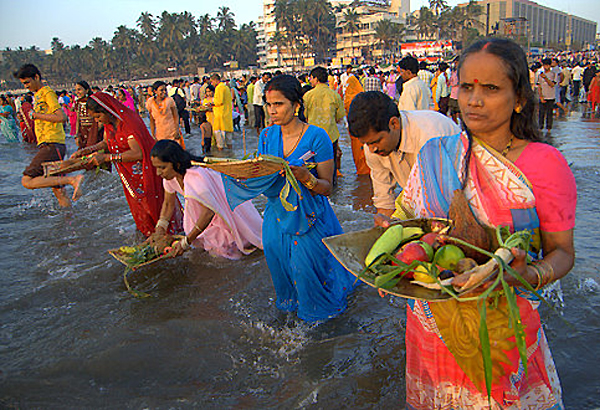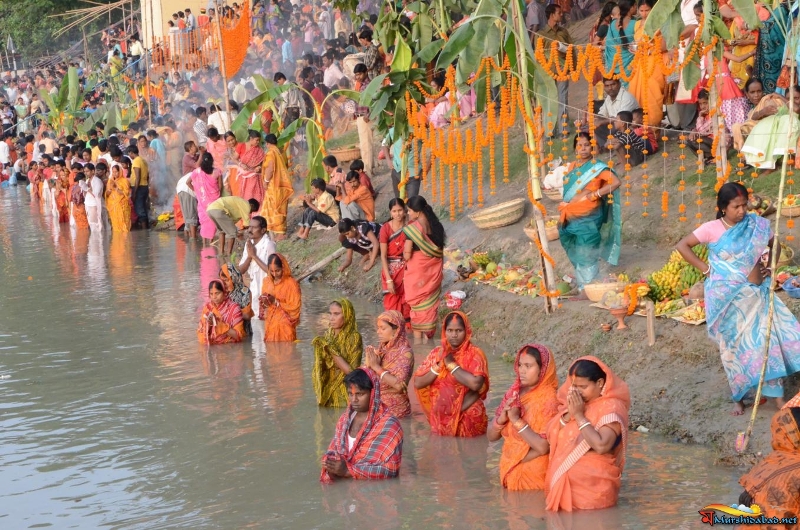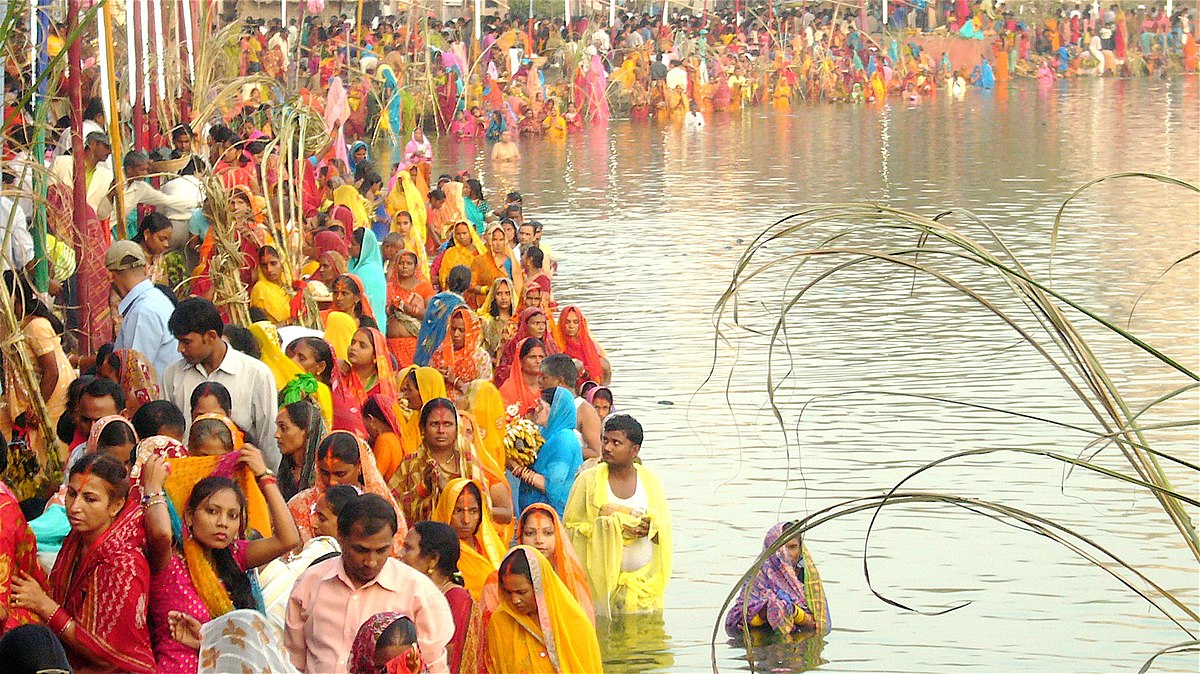ॐ श्री गुरुभ्यो नमः ॐ श्री शिवानन्दाय नमः ॐ श्री चिदानन्दाय नमः ॐ श्री दुर्गायै नमः
Source of all Images in this Blog-post : Google Images : ‘Google Image Search’ will reveal the multiple sources of every single image shared in this Blog. For more details, kindly see ‘Disclaimer‘

Chhath is an ancient Hindu Vedic festival historically native to the Indian subcontinent, more specifically, the Indian states of Bihar, Jharkhand and Uttar Pradesh and the Madhesh region of Nepal.
Chhath Puja is dedicated to the Solar deity (Surya) in order to thank him for bestowing the bounties of life on earth and to request the granting of certain wishes.
This festival is observed by Biharis & Nepalese along with their diaspora.
The festival does not involve idolatry and is dedicated to worship Lord Surya (the Sun deity). ‘ Chhathi Maiya ‘ is the mother goddess who provides strength and support to the poor. She is worshipped as the goddess of the festival.
The Sun is offered Arghya(offering/homage) in the evening of the first day and in the morning of the second day. And the rituals are rigorous and are observed over a period of four days.
The rituals include holy bathing, fasting and abstaining from drinking water (Vratta), standing in water for long periods of time, and offering Prasad (prayer offerings) and Arghya to the setting and rising sun.
Some devotees also perform a prostration march as they head for the river banks.
Environmentalists have claimed that the festival of Chhath is one of the most eco-friendly religious festivals that should be used to spread the message of nature conservation.
Moreover, it’s arguably one of few Hindu festivals that transcend the rigid caste system, which emerged in the post-Vedic period, to touch upon the ideas of “equality, fraternity, unity and integrity.
Every devotee-elite or middle class, any caste), prepares almost similar Prasad and other items to offer to the Almighty. All the devotees without any distinction in caste, colour or economy, arrive at the bank of rivers or ponds for extending prayers.

Although the festival is observed most elaborately in Madhesh (southern) region of Nepal and Indian states of Bihar, Jharkhand and UP, it is also more prevalent in areas where migrants from those areas have a presence.
It is celebrated in all Northern regions and major Northern urban centers in India.

Chhath Puja, also known as Surya Shashthi is celebrated on Kartik Shukla Shashthi. This festival is celebrated after 6 days of Diwali and mainly celebrated in the states of Uttar Pradesh, Bihar and Jharkhand with great devotion.
On Chhath Puja, worshiping Sun God and Chhathi maiya helps you gain health, wealth and happiness.
In the last few years, Chhath Pooja has got a special significance as a folk festival. This is the reason why the festival is celebrated with great pomp and show.
Significance of Chhath Puja & Chhathi Maiya :
The Chhath Puja is dedicated to the Sun God. The sun is the god visible to every being, is the basis of life of all creatures on earth .
Along with the Sun God, Chhathi Maiya is also worshipped on this day. According to Vedic Astrology, Chhathi maiya or Chhathi mata protects the offspring and provides longevity to them.

In the Hindu religion, the Shashthi Devi has also been known as Manas Daughter of Brahma ji. In the Puranas, she is also said to be the mother Katyayani, who is worshiped on Navratri on the Shashti date.
Shashthi Devi is said to be Chhath Maiya in the local language of Bihar-Jharkhand-UP.
As per legends, Chhath Puja is being performed from early Vedic period by sages who would fast for days and perform the Puja with Mantras from Rigveda.
It is believed that Chhath Puja was also performed by Karna, the son of Lord Surya and the king of Anga Desh, which is the modern day Bhagalpur in Bihar.
According to another legend, Pandavas and Draupadi also performed the Puja to overcome obstacles in their lives and gain their lost kingdom.

For the people from Bihar-UP-Jharkhand and other close by areas, Chhath Puja is considered as Mahaparva.
The Festival of Chhath Puja :
Chhath Puja is a folk festival that lasted four days. This is a four-day festival, which starts with Kartik Shukla Chaturthi and ends with Kartik Shukla Saptami.

Nahaye Khaye (first day) :
This is the first day of Chhath Puja. This means that after bathing, the house is cleaned and food after keeping it in front of the God is eaten to protect the mind from the vengeful tendency.
Kharna (Second Day) :
Kharna is the second day of Chhath Puja. Kharna means the fast of the whole day. On this day, the devotees are not allowed to drink even a single drop of water. In the evening, they can eat gur ki kheer (jaggery kheer), fruits and chapati (Bread) full of ghee.
Sandhya Arghya (Third Day) :
On the third day of Chhath puja, an arghya is offered to the sun god during the Kartik Shukla Shashthi. In the evening, a bamboo basket is decorated with fruits, thekua and rice laddus, after which devotees offer an arghya to the sun with their families.
At the time of Arghya, water and milk is offered to Sun God and the Chhathi Maiya is worshiped from a soop filled with prasad. After the worship of Sun God, Shashthi Devi songs are sung in the night and the vrat katha is heard.
Usha Arghya (Fourth Day) :
On the last day of Chhath puja in the morning, an Arghya is offered to the Sun God. On this day, before sunrise, the devotees have to go to the riverbank to offer an Arghya to the rising sun.
After this, the protection of the child from Chhathi Maiya and the happiness of the entire family is sought for peace. After worship, devotees drink sharbat and raw milk, and eat a little prasad in order to break one’s fast which is called Paran or Parana.
Chhath Puja Vidhi :
Chhat Puja Offerings
Get all the samagri before the Chhath puja and offer an arghya to Sun God:
● 1 large bamboo baskets, 3 soop made of bamboo or brass, plate, milk and glass
● Rice, red vermilion, lamp, coconut, turmeric, sugarcane, suthani, vegetable and sweet potato
● Pear, big lemons, honey, paan, whole herd, caravans, camphor, sandalwood and dessert
● As prasad, take thekua, malpua, kheer-puri, semolina pudding, rice ladoos.
Chhath Puja Arghya Vidhi :

Place the above Chhath puja samagri in the bamboo basket. Put the whole prasad in soop and burn the lamp in the soop. Then, all the women stand in knee deep water with traditional soop in their hands to offer an arghya to the sun.
Legend Associated with Chhath Puja :
The Chhathi Maiya is worshiped on the Chhath festival, which is also mentioned in the Brahma Vaivarta Purana.
According to a legend, King Priyavrat, son of First Manu Swayambhu, had no children. Because of this, he used to be very sad.

Maharishi Kashyap asked him to do a yajna. According to Maharishis orders, he performed a yajna for a son. After this, Queen Malini gave birth to a son but unfortunately the baby was born dead. King and other family members were very sad because of this.
Only then a craft seen in the sky, where Mata Shashthi was sitting. When the king prayed to her, then she introduced herself and said – I am the Manas daughter of Lord Brahma, Shashthi Devi. I protect all the children of the world and give the blessings of children to all childless parents.
After this, Goddess blessed the lifeless child with her hands, so that he was alive.
The king was very pleased with the grace of Goddess and he worshiped the goddess Shashthi Devi.
It is believed that after this puja, this festival is celebrated worldwide.
Religious and Cultural Significance of Chhath Puja :
Chhath Puja is a festival of religious and cultural importance. This is the only festival in which the Sun is worshipped and offered an arghya. Arghya is offered in the evening and in the morning to the setting and rising sun respectively.

The worship of the sun in the Hindu religion is of great importance. He is the only God whom we can see on a regular basis.
In the Vedas, the Sun God is called the soul of the world. The light of the sun has the ability to destroy many diseases. With the auspicious effect of the sun, the person gets health, wealth and self-confidence.
In Vedic astrology, the sun is said to be the factor of soul, father, ancestor, respect and high government services.
On the occasion of Chhath Puja, ‘Chhathi Maiya’ is also worshipped and hailed.
It is said doing this Puja brings fortunes, well- being for the children, pleasure and desire. Culturally, the main feature of this festival is the simplicity of tradition, love for purity and nature.
Types of Chhath Puja :
Chaitra Chhath – Distinctly known as “Chaiti Chhath”, this is observed in the Chaitra month of Vikram Samvat.
Kartik Chhath – Popularly called “Chhath”, this is celebrated at a very large scale in the Kartika month of Vikram Samvat.
Deo Surya Mandir World Top Sun Temple in Deo, Bihar, Aurangabad Bihar, India
Chhath is a Vedic ritual dedicated to Hindu solar deity Surya, and goddess Shashthi (also called Chhathi Maiyya).
It has also been mentioned in both the major Indian epics – In Ramayana, when Rama and Sita returned Ayodhya, then people celebrated Deepawali, and on its sixth day Ramrajya was established.
On this day Rama and Sita kept fast and Surya Shashthi/Chhath Puja was performed by Sita. Hence, she was blessed with Luv and Kush as sons. While in the Mahabharata, Chhath Puja was performed by Kunti after they escaped from Lakshagrih.
Rituals and traditions :
The main worshipers, called Parvaitin (from Sanskrit Parv, meaning “occasion” or “festival”), are usually women. However, many men also observe this festival as Chhath is not a gender-specific festival.
The Parvaitin pray for the well-being of their family, and for the prosperity of their offspring.
In some communities, once a family member starts performing Chhath Puja, it is their compulsory duty to perform it every year and to pass it on to the following generations. The festival is skipped only if there happens to be a death in the family that year. If the person stops performing the ritual on any particular year, it stops permanently and one cannot resume it.
In other communities, this is not mandatory.
Chhath Puja is a four-day event. Entire house, its surrounding and pathways to the Ghaat is thoroughly cleaned. It starts with
- Kaddu Bhaat or Nahai Khai – The Parvaitin cooks the most Satvik Kaddu Bhaat (Bottle Gourd and Bengal Gram Lentil preparation with Arva Rice Bhaat) This preparation is served to the deity in the afternoon as Bhog. This initiates the parv and is the last meal of the Parvaitin during Chhath Puja
- Kharna – This is observed the next day of Kaddu Bhaat or on the eve of Pahli Arag (Arghya). The preparation starts in the afternoon. Parvaitin Cooks a Rice and Jaggery Kheer with Dosti Poori, other seasonal fruits and dry fruits as also offered to the deity as naivedya (bhoga)
- Pahli Arag
- Dusri Arag
The Prasad offerings include sweets, Kheer, Thekua and fruits (mainly sugarcane, sweet lime and banana) offered in small bamboo soop winnows. The food is strictly vegetarian and is cooked without salt, onions or garlic. Emphasis is put on maintaining the purity of the food.
Sandhya Arghya (evening offerings) :
This day is spent preparing the Prasad (offerings)at home. On the eve of this day, the entire household accompanies the Vratins to a riverbank, pond or a common large water body to make the offerings (Arghya) to the setting sun.
It is during this phase of Chhath Puja that the devotees offer prayers to the just setting sun. The occasion is almost a carnival. Besides the Vratins, there are friends and family, and numerous participants and onlookers, all willing to help and receive the blessings of the worshipper.
Folk songs are sung on the evening of Chhath.
After returning from Ghat to home the Vratins perform the ritual of Kosi Bharai.
In this ritual the Vratis along with other family members involve to perform all the rituals regarding Kosi Bharai. They take 5 to 7 sugarcanes and tie them together to form Mandap and beneath the shed of that Mandap 12 to 24 earthen lamps are burnt and offerings like Thekua and other seasonal fruits offered there.
The same ritual is repeated in the Ghat next morning in between 3:00 am to 4:00 am and afterwards the Vratis offers Arghya or offerings to the rising sun.
